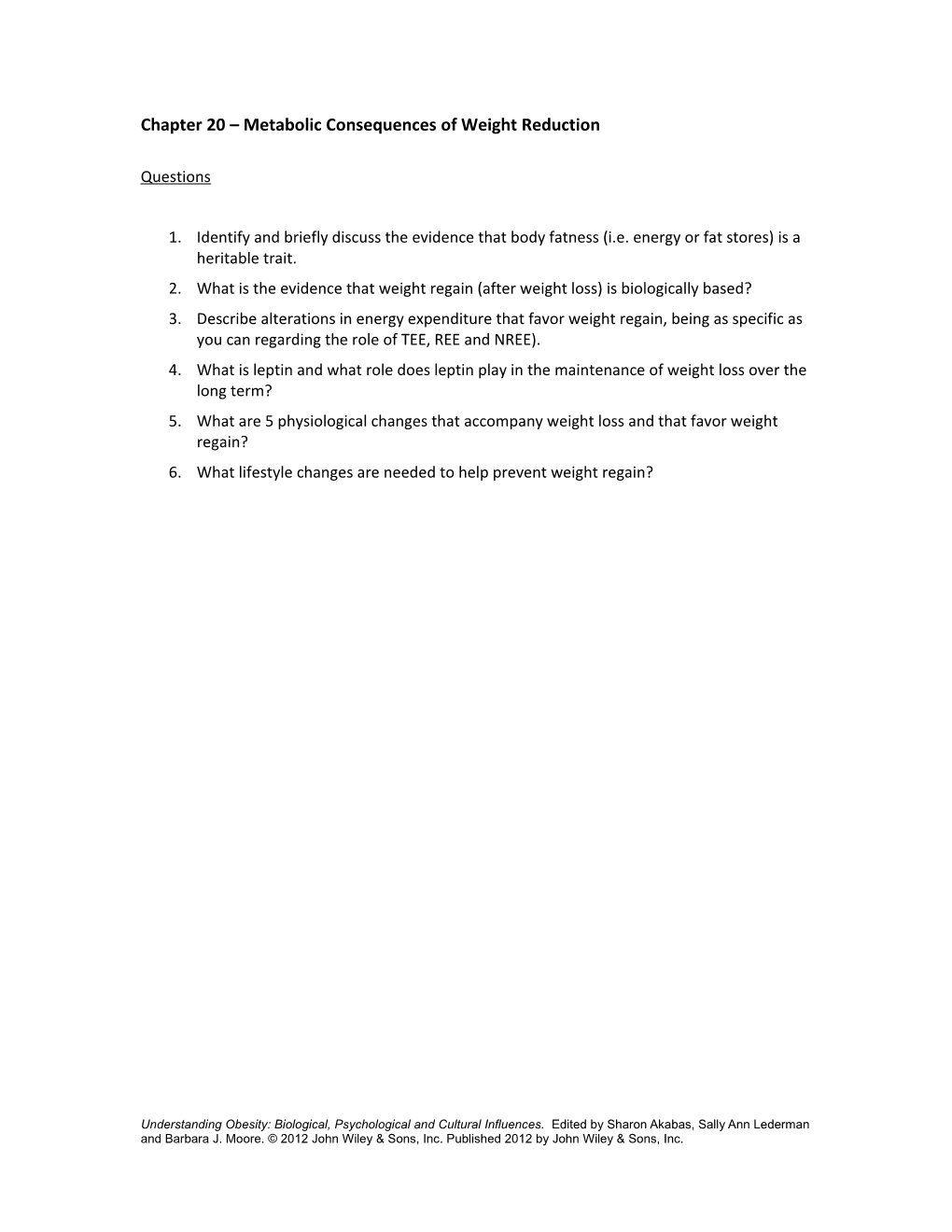Chapter 20 –Metabolic Consequences of Weight Reduction
Questions
- Identify and briefly discuss the evidence that body fatness (i.e. energy or fat stores) is a heritable trait.
- What is the evidence that weight regain (after weight loss) is biologically based?
- Describe alterations in energy expenditure that favor weight regain, being as specific as you can regarding the role of TEE, REE and NREE).
- What is leptin and what role does leptin play in the maintenance of weight loss over the long term?
- What are 5 physiological changes that accompany weight loss and that favor weight regain?
- What lifestyle changes are needed to help prevent weight regain?
Chapter 20 –Metabolic Consequences of Weight Reduction
Answers
- Twin studies comparing monozygous to dizygous twins and studies of adoptees raised apart from their biological parents (and compared to their adoptive as well as biological parents) suggest that body fatness is a heritable trait. Other components of body weight homeostasis that reflect significant genetic influence include: body fat distribution (where fat is located on the body), resting metabolic rate (the rate at which energy is expended), feeding behavior, food preferences and changes in energy expenditure in response to overfeeding. The existence of single gene mutations that produce profound increases in body fat content is another line of evidence that body fat is an inherited trait.
- Numerous studies in children and adults suggest that after weight loss, 80%-90% of subjects return to their previous weight percentiles. This inability to maintain lost weight is interpreted to suggest that energy stores (fat stores) are defended by biological mechanisms coordinated by signals emanating from adipose, gastrointestinal and endocrine tissues, and integrated by the liver and central nervous system.
- Studies show that individuals who undergo weight loss (using a variety of different methods) experience a decline in total energy expenditure (TEE) that is greater than can be explained solely on the basis of the amount of fat and lean mass lost. Thus, there is a difference between a weight-reduced individual and a matched individual of identical weight and body composition who was never obese.There is some evidence that resting energy expenditure (REE) declines with weight loss, but other evidence suggests that non-resting energy expenditure (NREE), i.e., energy expended in physical activity, is the component of TEE that is most affected by changes in body weight. This assertion is further supported by the importance of regular exercise in those who undergo successful weight reduction and maintain their lost weight. Other evidence in both animals and humans suggests that weight loss is accompanied by increased (not decreased) physical activity, suggesting that the decreased energy expended in physical activity must reflect significantly increased efficiency with which that activity (both exercise and non-exercise activities such as fidgeting) is performed.These effects are most evident at low levels of work associated with carrying out activities of daily living suggesting that overcoming the biological opposition to weight loss requires exercising at higher levels of power output.
- Leptin is an adipocyte-derived protein molecule that circulates in weight-stable individuals in direct proportion to fat mass. Decreased leptin as a result of reduced fat mass would have the net effect of stimulating food intake. Administration of leptin to leptin-deficient rodents and humans in doses that restore circulating leptin concentrations to their physiological range increases energy expenditure, decreases energy intake, increases sympathetic nervous system output, and normalizes hypothalamic-pituitary-adrenal, thyroid, and gonadal function. Yet, in humans and rodents who are not leptin-deficient, induction of weight loss requires doses of leptin that produce plasma leptin concentrations over 10 times normal. Recent studies of the short-term administration of leptin to weight-reduced lean and obese subjects suggest that restoration of circulating concentrations of leptin to levels present prior to weight loss reverses the hypometabolism, decline in thyroid hormones, decline in SNS tone, as well as the delayed satiation and fMRI changes in response to food that characterize the weight-reduced state. In this sense, the weight-reduced state may be perceived by CNS tracts relevant to energy homeostasis as a state of relative leptin deficiency. In this context, pharmacotherapy activating the leptin-signaling pathway may prove to help weight-reduced individuals sustain their weight loss.
- Other important physiological changes that accompany weight loss and that appear to favor weight regain include the following:
- Increased activity of the hypothalamic-pituitary-adrenal (HPA) axis
- Decreased activity of the hypothalamic-pituitary-thyroid (HPT) axis
- Decreased activity of the hypothalamic-pituitary-gonadal (HPG) axis
- Decreased circulating levels of leptin
- Integration of food intake and energy expenditure by the hypothalamic pro-opiomelanocortin (POMC)-melanocortin-4 receptor (MC4R) pathway which has neuronal outflow tract to the Autonomic Nervous System (ANS), neuroendocrine axes and cortical tracts subserving food intake
- Declines in Sympathetic Nervous System (SNS) tone
- Increases in Parasympathetic Nervous System (PNS) tone
- Changes in both homeostatic and non-homeostatic mechanisms that favor increased food intake
- In addition to sustained control of food intake (portion control), sustained regular physical activity at higher levels of power output are likely needed to prevent weight regain.
Understanding Obesity: Biological, Psychological and Cultural Influences. Edited by Sharon Akabas, Sally Ann Lederman and Barbara J. Moore. © 2012 John Wiley & Sons, Inc. Published 2012 by John Wiley & Sons, Inc.
